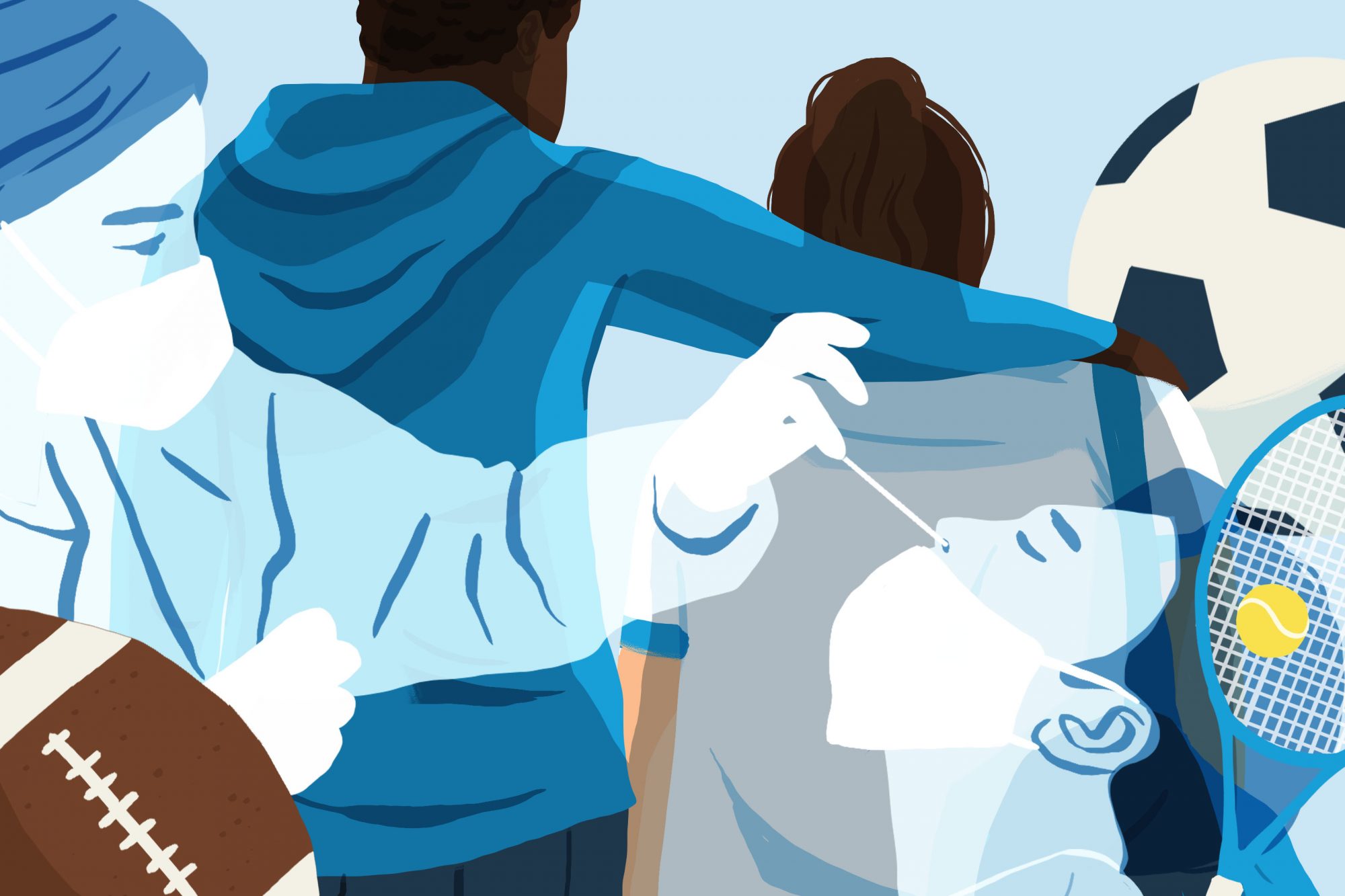
Long before she became a soccer icon, Alex Morgan was starting out on a team where her dad, Michael Morgan, was the coach. He didn't know much about soccer, she says, but took coaching classes to learn drills and the best ways to face competition on the field. Mr. Morgan also spent a great deal of effort on keeping his young athletes engaged. His soccer motto: fun first. He did that by incorporating games into practice like tag but with the soccer ball at their feet and sharks and minnows.
"When I think of our soccer practices when I was younger, I think of all these really fun games that got us active and moving and helped with the technical side," says Morgan. "But it was all hidden underneath the overall theme, which was really having fun with my friends and my teammates."
Morgan credits that focus on fun as the reason she pursued her athletic career—and a very successful one too. She's helped the U.S women's national team win Olympic gold and the FIFA Women's World Cup. She's also one of the U.S. women's national team's top five all-time leading goal scorers with more than 100 goals. "Why I'm playing today is because I never got burnt out. My parents always wanted me to do what I wanted to do. They never wanted me to do what they wanted," says Morgan, who also plays forward on the Orlando Pride of the National Women's Soccer League. "That was the first thing that I think helped me fall in love with soccer and want to be a professional soccer player when I grew up."
Now a mom to a 1-year-old, Morgan is advocating for youth sports by partnering with Gogo Squeez in a new campaign that focuses on putting fun first and offering a new playbook with tools for parents, coaches, and teachers to help implement that. Experts agree that as students and youth athletes return to practice as it's deemed safe in their neighborhoods, changes need to happen in the games. Health and safety are a big priority, of course, but so is the need for fun.
Why Fun in Sports Matters for Kids
From a young age, children primarily learn through play. As they grow older, freedom to play gets replaced with the pressure to succeed. But it doesn't have to. As Morgan's dad realized, integrating play into practice can teach necessary skills and build player endurance while keeping kids engaged. And without youth engagement, you don't have a team.
There's been a major decrease in engagement and enrollment over the past few years. Statistics show kids have lost interest in sports during the pandemic and 44 percent of families said their local sports program either closed, merged, or returned with limited capacity due to COVID-19, a survey by the Aspen Institute and Utah State University found. Already 70 percent of kids in the U.S. stop playing sports by the time they turn 13, when they say it's not fun anymore, according to a poll from the National Alliance for Youth Sports. A big way to keep these kids involved again is to bring fun back into the games.
Put simply: Kids have been through a lot during the pandemic and their mental health has been heavily impacted. Reports show kids 5 to 12 have experienced elevated symptoms of depression, anxiety, and psychological stress. Teens are also facing similar mental health challenges. In October, the American Academy of Pediatrics (AAP), American Academy of Child and Adolescent Psychiatry (AACAP), and Children's Hospital Association even declared a national emergency in children's mental health as emergency department visits for mental health emergencies increased by 24 percent for kids ages 5 to 11 and 31 percent for those ages 12 to 17.
While participating in physical activity isn't a cure for the mental health crisis, it does have many benefits. Sport gives kids an outlet for personal development. Team activities help improve self-esteem, goal setting, and leadership. They also help build friendships and bonds, and needed connections that were lost during the pandemic. Those with low social connections are more likely to develop mental health conditions, including anxiety, depression, antisocial behavior, and suicidal behaviors.
"If we've recognized anything throughout COVID, it's that sports are extremely valuable for both physical and mental health," says Drew Watson, M.D., M.S., a primary care sports medicine physician and chief medical advisor at Elite Clubs National League, a national youth soccer league founded in 2009. "The loss of sports had kind of catastrophic impacts on mental health, and dramatic impacts on reducing physical activity levels in children."
7 Changes Experts Want to See in Youth Sports
One thing all experts agree on is kids need to stay active and the benefits of doing that through sports can be huge. But the adults in charge need to keep kids engaged while also keeping them safe.
1. Plans to Prevent the Spread of COVID-19
"We have to be mindful that while COVID is going on that we are undertaking risk mitigation strategies that reduce the risk of transmission during sport," says Dr. Watson. That includes monitoring for COVID-19 symptoms, staying home when feeling sick, quarantining if you've been exposed to someone with the virus, practicing good hygiene like hand-washing, and disinfection of high contact surfaces at facilities. It's also important to minimize the time spent aggregating in closed spaces indoors whether that be in locker rooms or for team meetings. The Centers for Disease Control and Prevention (CDC) also advises vaccination for all kids eligible. "The risk of transmission when those things are done during sports, appears to be relatively minimal and hopefully tolerable given all the benefits they provide," adds Dr. Watson.
2. Kids Set Their Own Goals
A big first step to keeping kids engaged in sports is for parents and coaches to communicate with the players. Some kids play in hopes of a college scholarship or to one day play professionally. Others may strictly want to play sports for recreation. Both are OK. Let kids set their own goals—that also means allowing them to stick to one sport or letting them play on a variety of teams.
"When young athletes start doing things in service of goals that don't come from themselves, that's really when we run into issues around difficulties with burnout, difficulties with mental health issues, and ultimately, dropping out of sport participation," says Dr. Watson, also a dad and soccer coach to kids between ages 11 to 14. "When young athletes are given the opportunity and the support to kind of identify appropriate and realistic goals for themselves and they're given the freedom to kind of choose what it is that they want to pursue, and we put ourselves in a position to support them, I think that's really when we end up with young athletes who develop a lifelong love of their sport and become physically active through the rest of their lives."
3. Positive Experiences Prioritized Over Winning
Coaches, of course, play a big role in fostering a healthy experience. "Coaches can do that by their demeanor, by staying positive," says Jon Solomon, editorial director of the Aspen Institute Sports & Society Program. "That doesn't mean that you don't create some discipline if needed, it doesn't mean that you don't correct mistakes that occur in the field or on the court. But it's recognizing that, particularly now, coming out of a pandemic, there are a lot of kids that are struggling with mental health, and they need the socialization, they need a positive experience, they need to have a safe place where they can go and play and not have to be worried or stressed out if they make a mistake."
Research shows a negative atmosphere can force kids out of sports with the National Alliance for Youth Sports also finding kids stopped playing because there was too much pressure from their coach. "A coach can make or break that experience," says Solomon. "They could get kids to continue loving that sport, or loving sports in general, or it could get them to just give it up altogether."
Experts point out most youth coaches aren't adequately trained in mental skills. Even the language coaches use can make a big difference, L. Kevin Chapman, Ph.D., a clinical psychologist and expert for the sports education tool TrueSport, said in a video interview with the Aspen Institute. Rather than telling a child a punishing statement like, "Stop turning the ball over," for example, a coach can use a more reinforcing statement like, "Have better ball control." That can help build up a child's confidence.
4. Parental Involvement and Advocacy
Many youth coaches tend to be volunteers. Solomon is a volunteer coach himself for his son's soccer team of seventh and eighth graders and knows time can be a major factor. "There's only so much that leagues and clubs feel that they can ask of volunteers to go through with training, but it could be embedded into the training that already occurs," advises Solomon.
That's where parents can also step in. They can advocate for their kids through communication with coaches and school sports programs, especially if they notice a negative environment. Parents should advocate for a caring climate, says Lindsey Blom, Ed.D., CMPC, a professor of sport and exercise psychology at Ball State University and executive board member for the Association for Applied Sport Psychology. Research published in the Journal of Clinical Sport Psychology found that a caring environment "may facilitate athletes' use of psychological coping skills and set athletes up to perform their best and have a positive sporting experience." The opposite of a caring climate is coaches who are too focused on winning, are more critical than they are supportive, or are not fostering a collaborative environment.
But parents should also have conversations at home. Parents should pay attention to kids voicing concerns about not wanting to go to practice or games, says Dr. Blom, also a youth soccer coach for more than 15 years and a mom to an eighth-grader and a third-grader. "One time, two times, three times may not be an issue. But if we're finding a pattern that it's always on Tuesday, which happens to be this particular coach, and this particular session, that might be important," she says. Once a parent notices those patterns, they should ask questions like, "Why don't you want to go?" "What would make it better?" or "What would make you want to go?" Sometimes it's OK to push kids to do something that's good for them in a safe environment, adds Dr. Blom, but if they are still not having fun after a few more sessions, it might be time to take a break.
5. Personal Check-Ins For Players
It's important for those in charge of sports teams to check in with their players off the field as well. That's something Skyhawks Sports Academy has implemented since COVID. The Skyhawks Sports Academy has been around for more than 40 years and provides skill-based instruction for kids 2 to 14 in a variety of sports through several different programs. "We've included a lot more discussion with the children at our programs on how things are going at home and different things so that they can check in with themselves and be more aware and share experiences," says Matt Junior, a dad of a toddler and one on the way, who is part of the corporate team at Skyhawks Sports Academy. "It happened at programs in the past, but it wasn't something that we required instructors to make sure that they built into the lesson plan. Now we're trying to make sure that we're there for the whole well-being of the child, not just kind of the sport side."
Junior, who played soccer, wrestling, and baseball all through high school, understands that competitive sports do have a different level of expectation. "As kids get older, and athletes get older, they do need to understand the training piece and the dedication that's a part of that and that's not always fun—there is sacrifice, and there's hard work and commitment," says Junior. "But you also need to remember why you got involved in the first place." After spending almost 10 years with Skyhawks Sports Academy, Junior says he understands how similar strategies can be implemented in competitive sports. For example, coaches can make time to check in on players at their practices or after games. And they should implement fun elements like games in the training to allow kids to let loose, maintain their love for the sport, and still get a high level of training.
6. Access for All Kids
Not every kid has the same access to sports and that's only getting worse. "Kids should have the ability to play at little or no costs, and that's not really the case today," says Morgan. "Especially with the pandemic, funding really decreased even more significantly. A lot of leagues and teams shut down for a period of time or indefinitely."
That's on top of the fact that sports are expensive. Some sports cost parents an average of more than $1,000 a year and can go up to five figures. Even the least-expensive sports can end up costing parents more than $9,000 a year. "But it's not just costs. It could just be access to quality fields, it could be access to transportation, just being able to get to practice," says Solomon. "It's why school sports is one of the best ways to reach kids because they're right there in your building." That's also an issue for many students as low-income schools get less funding and some don't even have sports teams.
"My hope is that as we're looking at ways to fund infrastructure across the country, to support different initiatives post-pandemic, we're really prioritizing the role that sports play for children and looking at ways that we can improve access and reduce barriers and getting more kids participating," says Dr. Watson.
7. Sports Remain Fun
Yes, again, it's all about having fun. That's a big thing Morgan hopes is true for her daughter, who is naturally around sports—Morgan's husband, Servando Carrasco, is also a soccer player. The toddler has already shown an interest in soccer, even dribbling the ball around the field after her mom's recent game. But Morgan says she's not forcing her daughter into anything and instead wants to give her as much encouragement as possible if she does opt to pursue sports.
"If that means me getting out on the field with her or totally stepping back and just being Mom and being on the sidelines—that's totally fine," says Morgan. "It's all about really letting her take the lead."





